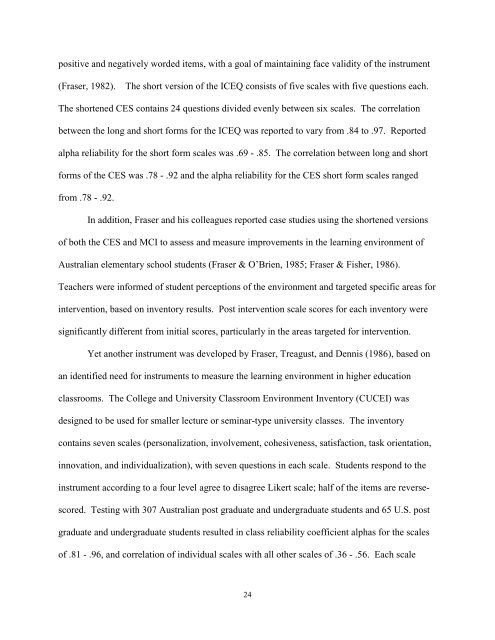STUDENT EVALUATION OF CLINICAL EDUCATION ENVIRONMENT
STUDENT EVALUATION OF CLINICAL EDUCATION ENVIRONMENT
STUDENT EVALUATION OF CLINICAL EDUCATION ENVIRONMENT
Create successful ePaper yourself
Turn your PDF publications into a flip-book with our unique Google optimized e-Paper software.
positive and negatively worded items, with a goal of maintaining face validity of the instrument<br />
(Fraser, 1982). The short version of the ICEQ consists of five scales with five questions each.<br />
The shortened CES contains 24 questions divided evenly between six scales. The correlation<br />
between the long and short forms for the ICEQ was reported to vary from .84 to .97. Reported<br />
alpha reliability for the short form scales was .69 - .85. The correlation between long and short<br />
forms of the CES was .78 - .92 and the alpha reliability for the CES short form scales ranged<br />
from .78 - .92.<br />
In addition, Fraser and his colleagues reported case studies using the shortened versions<br />
of both the CES and MCI to assess and measure improvements in the learning environment of<br />
Australian elementary school students (Fraser & O’Brien, 1985; Fraser & Fisher, 1986).<br />
Teachers were informed of student perceptions of the environment and targeted specific areas for<br />
intervention, based on inventory results. Post intervention scale scores for each inventory were<br />
significantly different from initial scores, particularly in the areas targeted for intervention.<br />
Yet another instrument was developed by Fraser, Treagust, and Dennis (1986), based on<br />
an identified need for instruments to measure the learning environment in higher education<br />
classrooms. The College and University Classroom Environment Inventory (CUCEI) was<br />
designed to be used for smaller lecture or seminar-type university classes. The inventory<br />
contains seven scales (personalization, involvement, cohesiveness, satisfaction, task orientation,<br />
innovation, and individualization), with seven questions in each scale. Students respond to the<br />
instrument according to a four level agree to disagree Likert scale; half of the items are reverse-<br />
scored. Testing with 307 Australian post graduate and undergraduate students and 65 U.S. post<br />
graduate and undergraduate students resulted in class reliability coefficient alphas for the scales<br />
of .81 - .96, and correlation of individual scales with all other scales of .36 - .56. Each scale<br />
24












